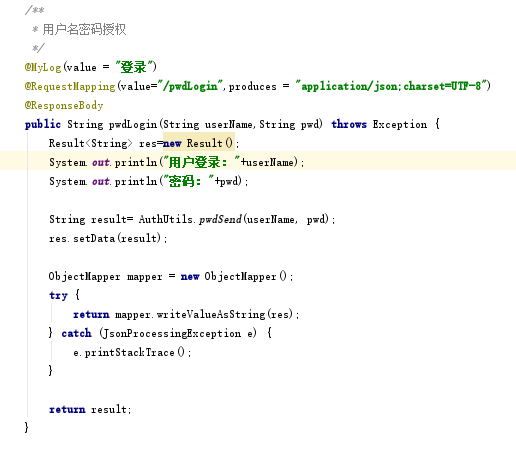This method is AOP annotation type printing log, as for log insertion, this paper will not introduce.
The details are as follows:
Using the Gradle Guide Package:
compile 'org.springframework.boot:spring-boot-starter-aop
Customize an annotation class. The code is as follows:
package cn.cityworks.domain;
import java.lang.annotation.*;
/**
* @author: zsx
* @date: 2019/4/17 0017
* This is a custom annotation class. Used to specify that XX access can be logged
*/
@Target(ElementType.METHOD) //The target location of annotation placement. METHOD is the annotated METHOD level
@Retention(RetentionPolicy.RUNTIME) //At which stage does annotation execute
@Documented //Generate documents
public @interface MyLog {
String value() default "";
}
Add tangent method class. The code is as follows:
package cn.cityworks.utils;
import javax.servlet.http.HttpServletRequest;
import cn.cityworks.domain.MyLog;
import org.aspectj.lang.JoinPoint;
import org.slf4j.Logger;
import org.slf4j.LoggerFactory;
import org.springframework.stereotype.Component;
import org.springframework.web.context.request.RequestContextHolder;
import org.springframework.web.context.request.ServletRequestAttributes;
import com.alibaba.fastjson.JSON;
import org.aspectj.lang.annotation.AfterReturning;
import org.aspectj.lang.annotation.Aspect;
import org.aspectj.lang.annotation.Pointcut;
import org.aspectj.lang.reflect.MethodSignature;
import java.lang.reflect.Method;
@Aspect
@Component
public class AspectLog {
//Define Pointcut @ Pointcut
//Cut in code at annotation location
@Pointcut("@annotation( cn.cityworks.domain.MyLog)")
public void logPoinCut() {
}
@AfterReturning("logPoinCut()")
public void saveSysLog(JoinPoint join) {
//Can be printed on the console
Logger log = LoggerFactory.getLogger(AspectLog.class);
//The method of obtaining the weaving point by reflection mechanism from the section weaving point
MethodSignature signature = (MethodSignature) join.getSignature();
//How to get the pointcut
Method method = signature.getMethod();
//Acquisition operation
MyLog myLog = method.getAnnotation(MyLog.class);
if (myLog != null) {
String value = myLog.value();
log.info("Operation:"+value);//Save acquired operation
}
//Get the requested class name
String className = join.getTarget().getClass().getName();
//Get the requested method name
String methodName = method.getName();
log.info("Method name"+className + "." + methodName);
//Requested parameters
Object[] args = join.getArgs();
//Convert the array of parameters to json
String params = JSON.toJSONString(args);
log.info("params:{}"+params);
ServletRequestAttributes attriButes = (ServletRequestAttributes) RequestContextHolder.getRequestAttributes();
HttpServletRequest request = attriButes.getRequest();
//Print url
log.info("url:{}", request.getRequestURL());
//Print request mode
log.info("requet_method:{}", request.getMethod());
//Print class method
log.info("class_method:{}", join.getStaticPart().getSignature().getDeclaringTypeName()
+ "."
+ join.getSignature().getName());
//Printing parameters
log.info("parameter:{}", join.getArgs());
//Print Ip
log.info("ip:{}", request.getLocalAddr());
}
}
The preparations have been completed. Next, add notes to the corresponding Controller layer (methods without notes will not be printed).
Take login as an example, and add the annotation @ MyLog(value = "login"):
Results:
